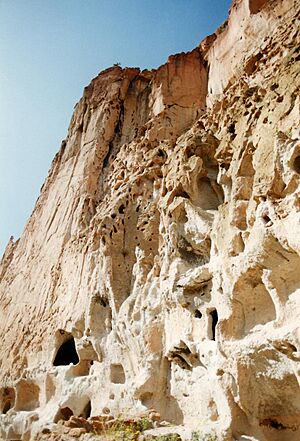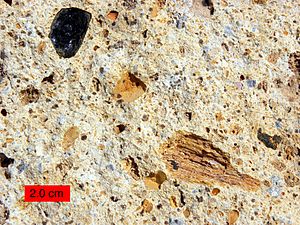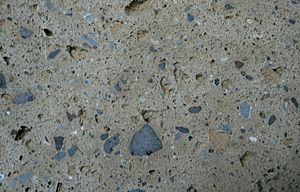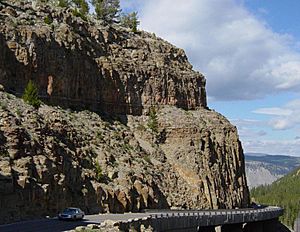Tuff facts for kids
Tuff is a type of rock that forms when volcanoes erupt. It's made from volcanic ash that gets packed together. If a rock is more than half tuff, it's called 'tuffaceous'. The stuff inside tuff changes depending on the melted rock (magma) it came from.

Contents
What is Volcanic Ash?
During a volcanic eruption, hot melted rock (magma) is blasted apart by gases and steam. This creates volcanic gases, lava, steam, and broken pieces called tephra. Any solid material thrown into the air is called tephra. If these pieces are small, less than 2 millimeters wide, they are called volcanic ash. These tiny bits are like sand-sized pieces of rock and magma. They are tossed into the air by powerful bursts of steam and other gases.
How Tuff Forms
Different Kinds of Volcanic Rock Pieces


When volcanoes erupt, they can throw out three main types of material:
- True ash, which is very fine.
- Chunks of older lava and tuff from the volcano's sides. These are ripped off by strong blasts.
- Pieces of sedimentary rock from deep inside the volcano. These can get heated and changed by the rising lava.
Sometimes, only the second type of material is thrown out, like during the Mount Bandai eruption in Japan in 1888. Other times, many broken sedimentary rocks mix with the ash. These pieces are usually sharp and jagged. If a rock has a lot of these sharp pieces, it's more like a 'volcanic breccia' than a true tuff. A breccia is a rock with sharp-edged fragments inside it.
Volcanic Bombs and Agglomerate
The ash pieces can be tiny dust or huge blocks over 20 feet wide. The large, rounded pieces are called 'volcanic bombs'. They often spin in the air as they cool, making them round or pear-shaped. Many have bumpy surfaces or cracks, like a loaf of bread. If a lot of these volcanic bombs are found in the ash, the rock is called an agglomerate.
How Tuff Becomes Solid
Fresh tuff is usually loose and crumbly. But older tuff often becomes solid. This happens because pressure and water seeping through the rock cement the pieces together. This makes the rock strong enough to be used for building, like in the area around Rome.
Tuff Under Water
Many volcanoes are near the sea. When they erupt, their ash can mix with mud and sand at the bottom of the ocean. This creates ashy muds, sands, or even ashy limestones. Many old tuff rock layers contain mixtures of clay, sand, and sometimes fossil shells. This shows that these tuff layers were laid down under water long ago.
Layers from Repeated Eruptions
Sometimes, a volcano will cover a large area with a thick layer of ash. But these layers get thinner the farther away they are from the volcano. Ash layers that cover many square miles are usually quite thin. Volcanoes often erupt many times, one after another. Because of this, thick tuff deposits often have many layers, like a cake. These layers can be very clear in fine ash beds.
Welded Tuff

Welded tuff forms from a super-hot flow of lava and ash. It's so hot that the pieces stick together as they cool. The glass shards and pumice fragments (light, bubbly volcanic rock) press together and become one solid rock.
A huge welded tuff flow, like the Lava Creek Tuff, erupted from Yellowstone Caldera in Wyoming about 640,000 years ago. This eruption was at least 1,000 times bigger than the 1980 eruption of Mount St. Helens. It was a VEI 8 eruption, which is the biggest type of eruption known in the last 10,000 years.
Basaltic Tuffs
Basaltic tuffs are a common type of tuff. You can find them in places like Skye and Mull in Scotland, and Antrim in Ireland. They are also found in older rocks in the Lake District and Wales.
Basaltic tuffs can be black, dark green, or red. They come in many different textures, from fine to coarse. Often, they formed under water and can contain shale, sandstone, and other sedimentary materials. Sometimes, they even have fossils. Newer basaltic tuffs are found in places like Iceland, the Faroe Islands, and the Sandwich Islands.
Images for kids
-
Ahu Tongariki on Easter Island, with 15 moai made of tuff from Rano Raraku crater: The second moai from the right has a Pukao ("topknot") which is made of red scoria.
-
The rhyolitic tuff portal of the "church house" at Colditz Castle, Saxony, designed by Andreas Walther II (1584)
See also
 In Spanish: Toba volcánica para niños
In Spanish: Toba volcánica para niños












